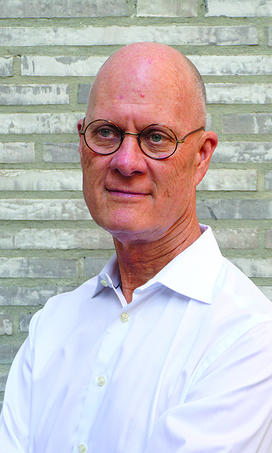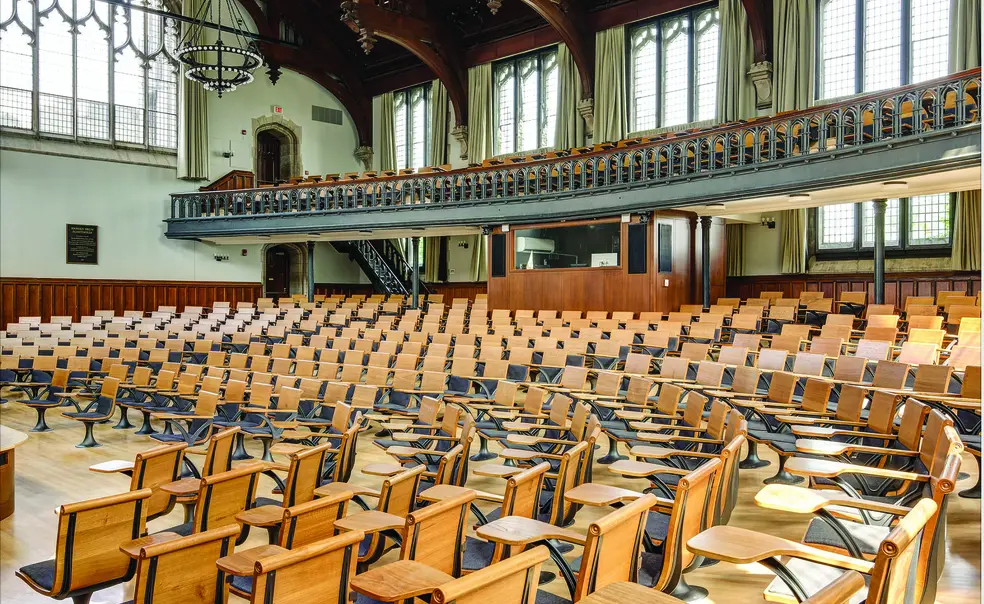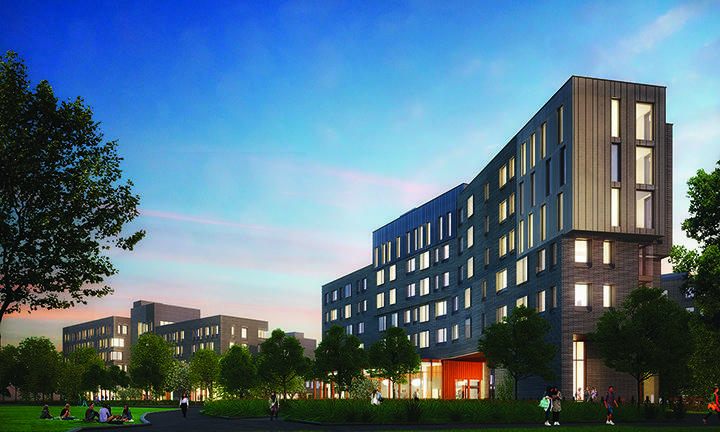Campus Grows With McCosh Makeover, New Residential Colleges

“It is one of the most iconic spaces on campus,” said University Architect Ron McCoy *80. “It’s just a glorious space that has all kinds of character-defining elements of the Princeton campus. It also is a real workhorse as a place for teaching.”
The University recently completed an overhaul of the 113-year-old hall, upgrading the technological tools that today’s faculty rely on — including the largest video screen in an academic building on campus — while aiming to maintain the character of the space.
McCoy said the project included improvements in visibility and acoustics. Subtle changes were made to the lighting, seating was adjusted to enhance sight lines, and acoustic-performing insulation was added to the ceiling, along with tiny perforations in the new wooden ceiling panels. The most noticeable change may be at the ground level: The installation of new wood flooring and subflooring has removed the familiar squeaks that made it nearly impossible for latecomers to slip into the room without being noticed.
The seats are also new, but at first glance, they appear nearly identical to the distinctive McCosh chairs used by generations of Princetonians. The new version includes a soft cushion — “to make those long lectures more comfortable,” McCoy said — and is about two inches wider and two inches deeper than the original (also for comfort, but perhaps a reflection of how body shapes have changed in the span of a century).
COVID-19 has delayed the renovated McCosh 50’s use for classes and events, but McCoy is looking forward to the hall’s next public lecture, whenever it may be. “I think the first impression will be that nothing has changed but it looks better,” he said.
While many of the University’s daily activities have been disrupted by the pandemic, construction on campus has progressed steadily. New Jersey Gov. Phil Murphy allowed higher-education construction work to continue in April and early May, when other projects were restricted by the state’s stay-at-home rules. In addition to the work at McCosh, two notable projects were completed over the summer: an interior renovation of Robertson Hall, which McCoy said will foster community and “serendipitous encounters”; and a reconfiguration of the engineering library, which has moved from the Friend Center to the space that bridges the Lewis Science Library and Fine Hall.
South of Poe Field, the foundations have been laid and steel framing is being erected for two new residential colleges — Perelman College and a yet-to-be-named eighth college — that are scheduled to open in the fall of 2022. Those colleges will usher in an expansion of the undergraduate student body, increasing enrollment by 125 students per year for a total of 500 additional students.The site of the residential colleges spans approximately 10 acres, including space formerly occupied by athletics facilities for soccer, softball, and tennis. New homes for those teams (as well as the varsity squash programs) are being built elsewhere. Soccer’s new Roberts Stadium will be east of Jadwin Gym and Princeton Stadium, and the FitzRandolph Observatory is being demolished to clear space for it. Stones from the observatory, which were originally part of its predecessor, the Halsted Observatory (1869–1932), will be saved for possible use in future projects, McCoy said.Softball will move to the new Lake Campus, on the southern side of Lake Carnegie. That area also will house the racquet center, which features courts for indoor and outdoor tennis and squash. The racquet center will have a fitness facility that will be open to the campus community, including those living in the new Lake Campus graduate housing, targeted to open for the 2023–24 academic year.
Other campus projects on the horizon include:
- New environmental-studies and School of Engineering and Applied Sciences facilities on Ivy Lane to provide state-of-the-art research space for several departments and programs, including geosciences, ecology and evolutionary biology, the High Meadows Environmental Institute, chemical and biological engineering, and bioengineering. This work is in the design phase, McCoy said.
- Schmidt Hall, the expanded and refurbished Guyot Hall, which will be home to the computer science department as well as the Center for Information Technology Policy, the Center for Statistics and Machine Learning, and the Princeton Institute for Computational Science and Engineering (see PAW’s July 10, 2019, issue).
- A new home for the Princeton University Art Museum, designed by Sir David Adjaye and Cooper Robertson (see PAW’s November 2020 issue).
- Hobson College, designed by the team of PAU, Hanbury, and Joel Sanders/MIXdesign. This will replace First College (the former Wilson College) after the two new residential colleges are completed.
Beneath some of the new construction will be what Princeton’s facilities staff sees as the future of campus energy: geothermal wells — each about 850 feet deep — used in a system that circulates water for heating and cooling buildings. Converting the campus from steam to the more energy-efficient geothermal system will play a significant role in the University’s quest to be carbon-neutral by 2046, McCoy said. A new building known as TIGER (Thermally Integrated Geo-Exchange Resource), on the corner of FitzRandolph and Faculty roads, will manage the system on the East Campus. “People will not see [the geothermal system] the way you see a new art museum, but it’s a significant investment in the infrastructure of the future campus,” McCoy said.
What are your favorite McCosh 50 memories? Send your memories of lectures, speakers, and more to paw@princeton.edu or send a comment to Inbox below. Responses may appear in a future issue.














9 Responses
Anne Clothier Haydon ’80
3 Years AgoA McCosh Memory
Entering McCosh 50 for a freshman-year survey course, I scoured the rickety front row seats for an impossible dream: a left-handed desk for my sinister writing requirements. Dashed as I was, I settled for, and into, a dexterously outfitted seat, contorted my body, spiral notebook, and pen, and proceeded to listen to the professor blissfully as I unwound my twisted form. It was then I discovered that, unlike high school, college lecture halls were not primarily meant for writing.
Sam Logan ’65
4 Years AgoMcCosh 50 with Reinhold Niebuhr
In 1963, Reinhold Niebuhr taught a course on “Democracy and Totalitarianism” and, of course, it had to be held in McCosh 50 because enrollment was “limited” to 450 students. I was delighted to have the privilege of taking the course and no, I don’t remember anything that I learned in the course! (But then, that was a very long time ago.)
Greg Griffin ’71
5 Years AgoHidden in the Seats
The replacement of McCosh 50’s “squeaky floor and aging seats” brought to mind an article I wrote for The Daily Princetonian 52 years ago.
My article featured a discovery by Peter Malcolmson ’70: a wide range of detritus in the bases of McCosh classroom desks.
This memorabilia included a note from Alfred V. S. Olcott 1909 shortly after the completion of McCosh Hall. Also discovered were an empty box of Gillette “no honing, no stropping” razor blades and an empty Ex-Lax package. And empty boxes of Egyptian Deities and Lucky Strike Green cigarettes. There was too much to mention — Mr. Malcolmson unearthed three large boxes.
In PAW’s photo of McCosh 50 in the December article, the chair bases look solid. They appear to lack the openings in the old-style chairs. If so, what a shame! The new chairs may have cushions, but Princeton students will no longer be able to leave evidence of their culture behind, in their chairs, and later generations will have fewer clues to current and future generations’ thoughts, lifestyles, and habits.
Roland Zimany ’58
5 Years AgoA Powerful McCosh Memory
At a time when Billy Graham was going strong as an evangelist, a noted evangelist from England gave a talk one evening in McCosh 50. I was sitting in the balcony, and at the end of the talk, he called people to come forward to commit themselves to Christ.
I already was Christian, although with some questions, and at that time, I thought, “If God really is present, now would be the time for ‘Him’ to confirm that fact by making Himself known to me.” Shortly thereafter I was overwhelmed by a rush of energy, coursing through my body, that I had never experienced before (or since). It kept coming and coming, somewhat like a shiver, but much, much stronger. I thought, “This is the way God is making His presence known.” (And I still think so.) The force of the continuous energy receded, but it stayed with me, in decreasing doses, as I walked back to my dorm room.
Gail Finney ’73
5 Years AgoListening to Professor Litz
As a professor of comparative literature and German for 40 years, I have heard (and given) countless lectures about literature. But the lectures of A. Walton Litz ’51 in the course “Modern Literature,” held in McCosh 50 in the spring of 1970, still stand out for me. He commanded the room, containing a full audience, including a small sprinkling of females, during that first year of coeducation.
I would never have imagined that one could give an entire lecture on a single poem, but Professor Litz achieved this masterfully, holding us rapt. He was just as adept at lecturing on an author’s life or on a novel. The texts and authors in that course are for me still, more than 50 years later, bound up with the memory of A. Walton Litz and of that venerable lecture hall.
Landon Y. Jones ’66
5 Years AgoRemembering Albert Einstein at McCosh
We all have special memories of McCosh 50, gathered over the years. Mine include hearing Reinhold Niebuhr and John Updike there. But for sheer drama it would be hard to top Albert Einstein, who delivered his famous five lectures on relativity in McCosh 50 on May 9-13, 1921, during his first trip to the U.S. The lectures were later published in English by Princeton University Press.
Owen P. Curtis ’72 *75
5 Years AgoStudies in Theology at McCosh 50
The article about the growing campus and the upgrade to McCosh 50 brought back one of my favorite memories. When it was time for the Class of ’72 to select courses for our final semester, word got out that there was going to be a course with no grades, no quizzes or tests, nothing to do to get credit other than one “paper, program, or project,” as the course summary read. Religion 301: Studies in Theology was to be taught by Professor Victor Preller ’53 *65, a well-liked and appreciated lecturer.
We seniors scrambled to get our course cards in before Preller’s course was oversubscribed. The course had so many students sign up for it that the only academic room on campus large enough was McCosh 50. It was an evening lecture, so the first week of February, we headed over early to grab our seats. Seniors brought coolers of ice-cold beer and plunked ourselves in the balcony seats, awaiting Professor Preller. McCosh 50 was standing-room-only.
When he strolled out onto the stage, the hall erupted in applause. He waited for quiet, then walked slowly to the podium, scanned the “orchestra” seats from right to left, and back again. He then did the same for the balcony. Then, leaning in to the microphone, he calmly said, “We all know, don’t we?” He brought down the house, and received a standing ovation.
Preller was a great lecturer. It was a great evening escape to listen to him once a week that semester.
Peter G. Brown ’70
5 Years AgoWhat Happened in McCosh 50?
What happened in McCosh 50? That’s easy. Type “Daily Princetonian archives” into Google, and find your way into “The Daily Princetonian: Larry Dupraz Digital Archives.” (Larry was a Princeton Packet pressman assigned to the Prince account, who became the newspaper’s resident grown-up for many years.) Inside the archive, type “McCosh 50,” but first, do yourself a favor. Navigate to “Advanced Search” and limit your search to, say, hits for “McCosh 50” in your own years at Princeton.
My own browsing turned up a McCosh 50 lecture by the civil rights leader then known as Stokely Carmichael (Sept. 22, 1966); a midterm English 201 exam (Nov. 1, 1966); and a poetry reading by W.H. Auden (March 6, 1968).
Be careful, though: you might get lost...
Paul Wing ’62
5 Years AgoBob and Ray on a Winter Day
I was an engineering major so didn’t get into McCosh 50 very often, but I do have vivid recollection of a special event on a cold, damp midweek evening in February of 1962. Bob and Ray (for those too young to have enjoyed them, droll radio and TV humorists of the time) were scheduled to be there for a special event. The room was packed. The audience was starved for a laugh. Bob and Ray were late, really late, but nobody left.
Finally they arrived and as they took the stage to set up their mics and a little video screen, the place erupted with wild cheering and applause for what seemed an eternity. Bob and Ray just sat there on the stage not moving. Finally, as the cheering started to subside, Bob said simply, “Hello, Ray,” and the place erupted again. After another eternity, as the noise started to subside Ray said simply, “Hello, Bob,” and yet another eruption.
Eventually, they got down to business, which was trying out a number of new humorous radio and TV bits to be used in ads for Tip Top bread. The applause and cheers never matched the opening uproars, but hundreds of undergrads went back to their dorms filled with joy from this little break in their gray, dreary winter.